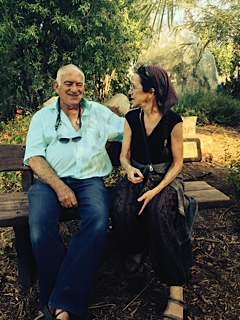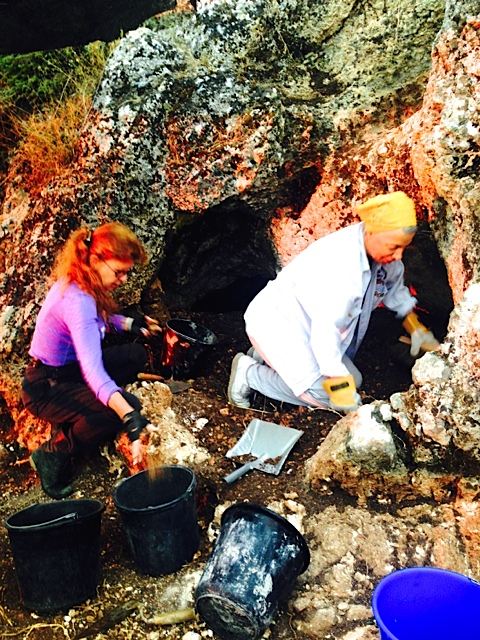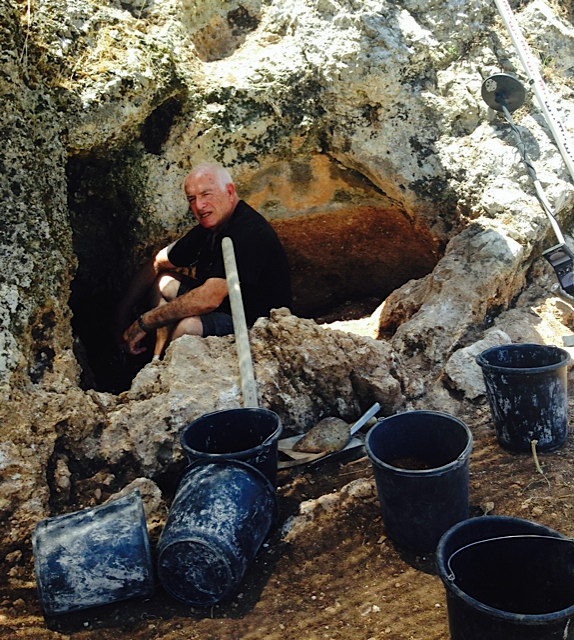by Martha Hellander
The team at Jezreel includes several volunteers in our 50s and above who have no obvious staff or academic role. We are here as amateurs in the original sense – we study archaeology for love.
(Mordechai Abraham and Martha Hellander visit the community garden in the German Colony, Jerusalem. – Photo by Martha Hellander)
Our backgrounds and reasons for joining the dig vary. We may be recently retired, our children grown or gone. Perhaps our work or family lives took us away from an early fascination with digging or playing on the land and at last we are free to indulge. We detach from our usual surroundings hoping to gain new perspectives on Israel, on the stories of the Bible, and especially on ourselves.
(Golden sunrise strikes the entrance of a cliff-dug cistern where Sheila Bishop (L) and Annette Mangus are working. – Photo by Martha Hellander)
Eager to challenge or renew our physical strength and endurance, we rise before dawn, lift heavy buckets and wield pickaxes and tourias alongside students who could be our grandchildren. We share meals with scholars whose learning we hope to absorb, and listen to kibbuz members eager to reflect on how they ended up here—stories that invariably include trauma from the deaths of beloved parents, siblings or grandparents in the Holocaust. Some of us may find it healing to provide witness when there is little else to offer.
(Mordechai Abraham of Jerusalem excavating a cistern above the wine-press. – Photo by Martha Hellander)
Before actual digging begins, we must clear wild oats, uproot caper bushes, topple clumps of giant fennel that waft the scent of licorice, and trample stalks of wild carrot and purple globe-thistles. You may hear the lifelong gardeners among us whispering apologies to plants we would cherish elsewhere. We scoop soil and scrape eroded rock with our hands, trowels and brushes to uncover what lies below while sharing ribald jokes and easy banter. We collect and tag the oxidized coins and dirt-encased basalt grinding stones, the animal bones and dusty glass, the pottery rims and handles, rusted horse shoes, the pointy flints, the nails, barbed wire, shrapnel and shell casings. We learn to measure and survey, and to build lightweight shade tents that billow and float like black sails on a sea of wild wheat. We handle ungainly tools with increasing precision and speed. We draw upon our life experiences and studies—in farming and landscaping, in stonemasonry and horsemanship, in software design and journalism, Biblical literature, organizational management, mathematics and the law—to predict the line of a wall, trace chisel marks along a waterway carved into a bedrock scarp, or interview old-timers about their lives. We come willing to be surprised by beauty—a glance up from our digging may connect with the gaze of a lean, long-horned heifer peering over some rocks, a regal white bird perched on her back. If we look down while walking, one might discover, as I did, the long wing-bones and feathers of a black stork that died, most likely by collision with the power lines, during migration from Africa to Europe. Any day we might unearth an iridescent beetle, a scorpion who raises tail and claws when startled, a wriggling knot of pink worms in a baulk, or the lime-green belly of a spider. We feel a keen gratitude for these gifts enhanced by our awareness of life’s caprice and berevity. Some of us come here because we feel more alive, or serene, or closer to the Divine at Tel Jezreel in the so-called Holy Land.



